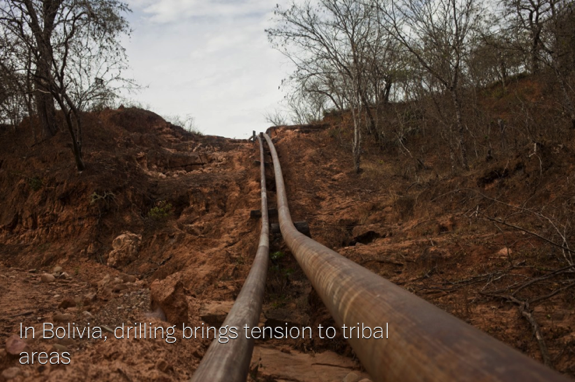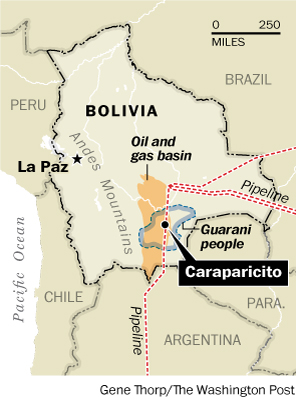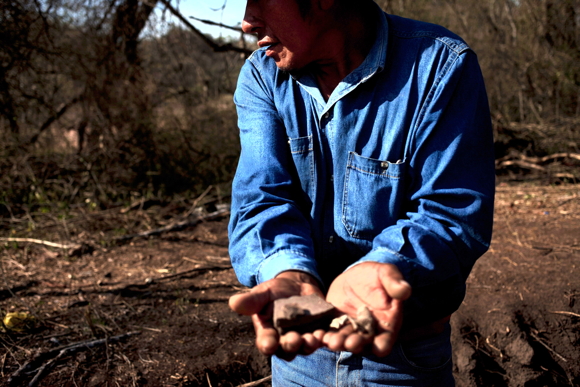
(above) The arrival of energy companies has brought protests from indigenous people whose land was recently returned to them. Sept. 23, 2014 Pipes connecting new gas drill sites run across land given back to the Guarani tribe by the Bolivian government. credit: Dominic Bracco II/Prime for The Washington Post
Gallery of 16 photos: click photo or photo text to go to original article to see photos.
Gas boom in Bolivia brings new wealth — and regrets for a lost opportunity
November 14, 2014 - Washington Post
By Nick Miroff
CARAPARICITO, Bolivia — For most of his life, Oscar Robles worked for an American landowner as a lowly ranch hand, "a peon," he says, tending cattle and corn for a light-skinned patrón as generations of Guarani laborers did before him.
Then Bolivia elected its first indigenous president, Evo Morales, who took office in 2006 pledging to right the historic wrongs committed against the country's ethnic minorities. Morales seized the American's land and other nearby properties, giving the Guarani their ancestral home back.
The American rancher fled. Robles became capitán, the new leader of Caraparicito.
Then he watched from the roadside as the drilling crews and construction equipment came roaring in, part of Morales's all-out push to develop Bolivia's gas fields and cash in on soaring energy demands in South America.
The Guarani had recovered their land, but the huge deposits of natural gas beneath it belonged to the government of Morales and its main partner here, the French energy giant Total.
 (left) credit: The Washington Post
(left) credit: The Washington Post
The gush of gas royalties has allowed Morales to vastly expand the reach of the Bolivian state and alleviate some of the worst poverty in the Americas. He was reelected by a landslide to a third term Oct. 12.
But the drive for new wells, pipelines and highways, especially here in the hydrocarbon-rich southern lowlands that resemble parts of Texas, has led to violent clashes between the government and indigenous groups such as the Guarani, many of whom once supported Morales but now say they've been swept aside.
"We called this place Aracayotal — place with fruit," said Robles, picking through a bulldozer mound with two younger Guarani men at the edge of a construction site where Total was building a new gas treatment plant. An oil worker in a hard hat watched them warily from a distance, speaking into a walkie-talkie.
"We didn't know it was a burial ground," Robles said.
Total's arrival has sown division among the Guarani and left many with a creeping sense of regret. At first the company's cash payments, infrastructure projects and job offers seemed like a good alternative to the old way of life under a land-owning patrón. Now they see a new, more powerful master moving in — this one with the backing of the government.
When some Guarani tried to stop the oil crews by blocking the road this year in protest, soldiers and riot police were sent in to clear them out.
Morales once campaigned against foreign companies in Bolivia for defiling the Pachamama — Mother Earth. Then he became president and seized control of Bolivia's petroleum industry, forming new joint-venture partnerships with some of the same foreign firms he had vilified.
(below) Oscar Robles holds bone fragments and shattered pieces of urns used to hold human remains that he found at a former burial site destroyed by the French energy giant Total to construct a natural gas flaring platform. (Dominic Bracco II/Prime)

In tiny Caraparicito, coca-chewing Guarani men walk around in polo shirts and denim button-ups with the Total logo even as they protest the company's presence.
Until a few years ago, it was an isolated rural hacienda like many others in this part of Bolivia, where Guarani laborers had lived for centuries at the service of their patrón, working in exchange for food, clothing and often little else.
Morales denounced this serf-like arrangement as "slavery." Starting in 2008, he moved to strip several property owners of their land and turned it over to the Guarani, to be managed and farmed collectively, just as their ancestors had before the arrival of European conquerors.
But now Total is spending $1 billion to drill 20,000 feet into the base of the Andes here and tap a gas mother lode estimated at several trillion cubic feet. It is building a massive processing plant on the pastures where Guarani once tended their masters' cattle. Pipelines will run from here to markets in Argentina and Brazil.
And on the hill above the plant site, where the company planned to put a flaring tower, the bulldozer crews in the summer plowed up an old, forgotten Guarani burial ground. Total said it halted construction and brought in an archaeology team to collect the bones and pottery shards for lab testing.
Robles poked around the edges of the clearing. Total, he said, hadn't done a very careful job.
He picked up a reddish-brown ceramic shard out of a dirt pile, then another and another. They were pieces of smashed funeral urns, he said. A slender grayish object poked out of the ground nearby. It appeared to be a fragment of a human pelvis.
The Guarani men climbed over the low berm left by the bulldozer to search the scattered debris on the other side. There were pottery shards several inches wide and a big rounded dirt clod that looked as if it had been molded inside a burial urn. Large, fully intact pieces of bone were pressed between layers of earth, perfectly preserved.
As they brushed away the soil, a tooth fell out — a molar. It was part of a jawbone, complete with a row of small teeth.
"A child," said Robles, cupping the teeth in his hands. "These are our ancestors."
Robles said no one knew how old the graves were. The Guarani had stopped burying their dead that way a long time ago.
They crouched down to pick through the bones and broken urns. One of the men grew agitated, but Robles fell quiet, looking as if he'd seen a ghost.
They put the bones in a plastic grocery bag and then drove back down the hill through the construction site and a cloud of dust.
Total's arrival
In 1968, Ronald Larsen drove his pickup truck from Montana to South America, looking for cheap land. He bought the rugged Caraparicito hacienda from a local family and then acquired more property after that, eventually taking control of more than 35,000 acres.
Along with the land, Larsen inherited a semi-feudal labor relationship with the Guarani who lived on the property. But over the years, Larsen built new homes for his workers, a school and a small chapel.
Since the nearest paved road was more than an hour away, Larsen would buy food and clothing in bulk during his trips to town, selling it to the Guarani at a discount, according to his son, Duston Larsen.
"We gave them rice, pork and beef," said Duston Larsen, who was born in Bolivia and still lives there. "Everything we gave them was free or below cost."
The Guarani who live in Caraparicito today do not remember Ronald Larsen this way. They describe him as a heavily armed overlord who paid miserable wages. Duston Larsen said the Guarani have been coached to say such things.
The government's showdown with the American peaked in 2008, when Ronald Larsen tried to drive off a land inspector by shooting at his tires. Larsen fought the confiscation of his property all the way to Bolivia's Supreme Court. He lost his final appeal in 2010 and left the country for Brazil.
Today, Larsen's 150-year-old hacienda is home to eight Guarani families. Chickens, puppies and toddlers scamper through his former kitchen. Wasp nests spread unchecked across the rafter beams. The once-grand fountains in Larsen's yard are choked with trash and buzzing with mosquitoes.
At the time of the seizure, Ronald and Duston Larsen had been developing the property into a dude ranch for tourists, offering horseback rides, mineral baths and sweeping views of the Andean foothills.
"This is where the gringitas would run around naked," said Hugo Molina, a Guarani activist, pointing to the ruined spa where he now stores sacks of corn. He had moved his family into the loft area above the sauna.
After more land seizures, the new Guarani community, Alto Parapeti, was formed. Some of theneighboring hacienda owners destroyed their own homes as they left, smashing roof tiles and tearing out anything of value. Guarani families moved in anyway and now live amid the ruins, hanging old blankets over the doorways to keep out the flies.
The Guarani tend animals and raise crops in the stream valleys as they always have. But they are struggling without the machinery, fuel and other supplies of their former masters. There are feuds over access to the best land, and those who resisted the property seizures are outcasts.
"My brother took the boss's side, so we didn't speak to each other for a while," said Alejandra Mendieta, the wife of a Guarani leader in a nearby community whose hacienda owner had been driven out.
She stood over a fire, boiling corn and sugar in an old oil drum to make the beverage chicha. "My brother cried because he didn't want the boss to leave," she said.
It was tough to tell whether the Guarani were better off now. David Jarillo, another Guarani capitán, said they had won "freedom." He'd worked for the hacienda owner for nine years, he said, for $7 a day. The government had given the community a new tractor, now parked in Jarillo's yard. A plumbing system and electricity for the community were coming, too, he said.
"The Guarani are trying to learn how to live communally again, but they aren't prepared and they need more time," said Alejandra Anzaldo, who works with the Guarani as the local director of a nonprofit rural development group, CIPCA.
Anzaldo said Total's arrival and its indemnity payments were dividing the Guarani before they had the chance to unify. There were suspicions about the management of communal funds. Others chafed at the construction noise and dust and work camps popping up everywhere. It didn't feel like progress, but there was no going back.
New conflicts
Total said that it suspended construction work at the burial site as soon as its crews found the bones and that it notified Robles, the Caraparicito capitán, and other Bolivian authorities, inviting them to visit the site.
The results of the lab tests on the bones and pottery shards were not available yet, the company said in a recent statement, but the urns would be reassembled and the skeletons reburied, with Guarani participation. No one knows yet how old they are.
On the day he found the bones and shards that Total had left behind, Robles sat in his front yard across from Larsen's old hacienda at sundown, watching the dump trucks and drilling equipment rumble by.
After dinner, a cheerful public relations official from Total drove up and took a seat beside him in the yard, among the chickens.
She reminded him that the phone company had been trying to get his permission to install new cellphone towers on the ridge. Two artists were coming to paint murals at the local school the following week. And had he been to the new health clinic yet?
The list was long and she spoke fast. Robles didn't seem to be paying attention. He nodded, staring out at the traffic going by.
Heavy equipment was headed up the mountain toward Incahuasi-1, the first well, drilled in 2004 when the land was still Larsen's but later sealed. Now Total was getting ready to reopen it once the processing plant came online. Big flatbed trucks strapped with generators and steel tubing were groaning and belching black smoke as they squeezed up the dirt roads.
Years ago, Robles once hiked up to the top of the ridge above the well site. There were Incan ruins there, he said. That's where the company got the name Incahuasi, meaning "place where the Inca live."
According to Guarani myth, it had been the outer edge of the Incan empire, until the Guarani finally drove them out in the days before the conquistadors. "The Inca liked to live on the tops of mountains, to be with their gods," Robles said. "But we Guarani always liked it here, in the valleys, closer to the earth."
The woman from Total was reminding him about the new drawing contest for the local schoolchildren. It was part of the company's social development plan for the Guarani.
The company wanted the children to draw pictures of what they thought the gas treatment plant would look like when it was finished next year, she said. There would be prizes for the winners.